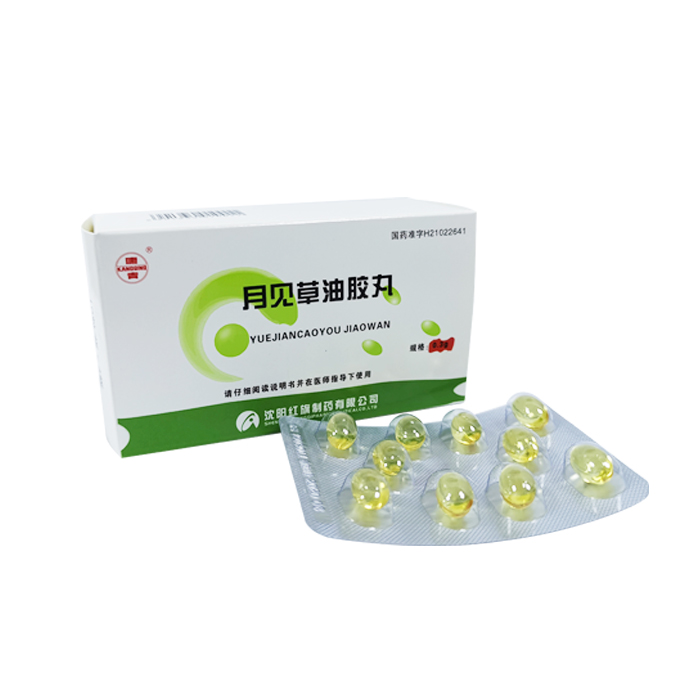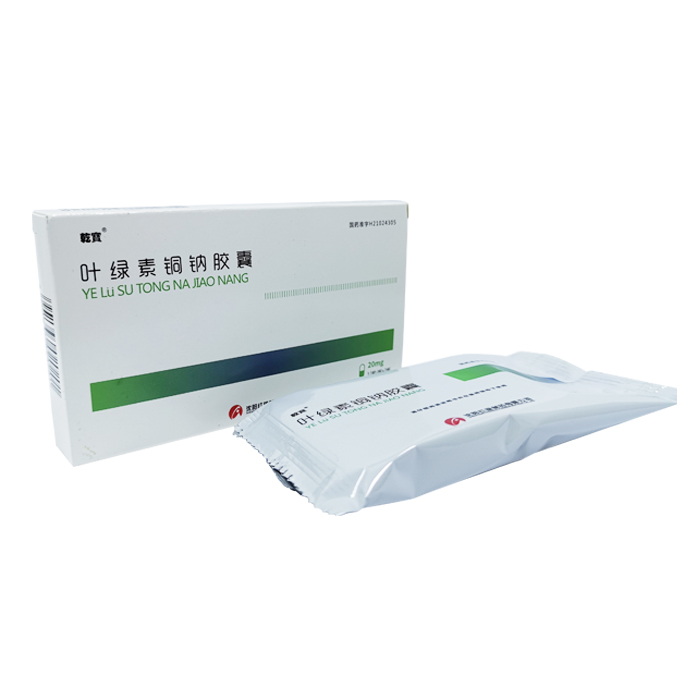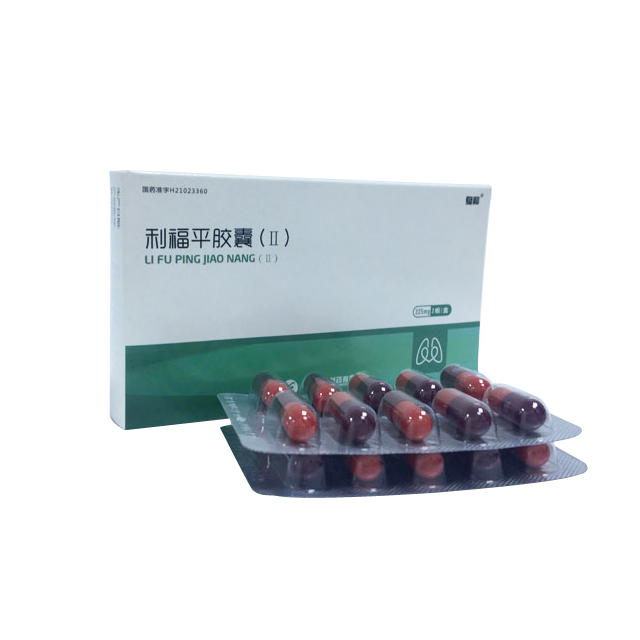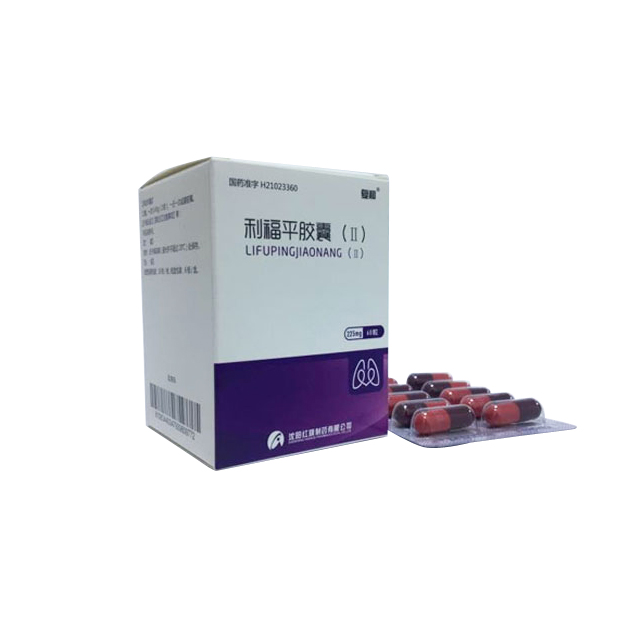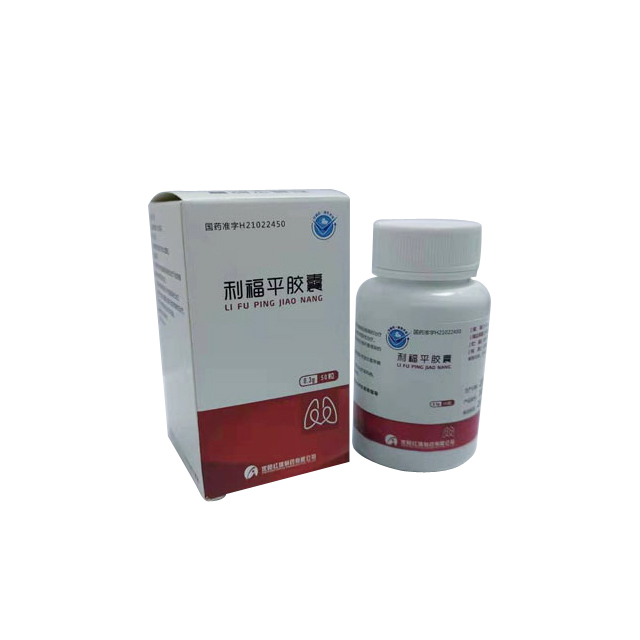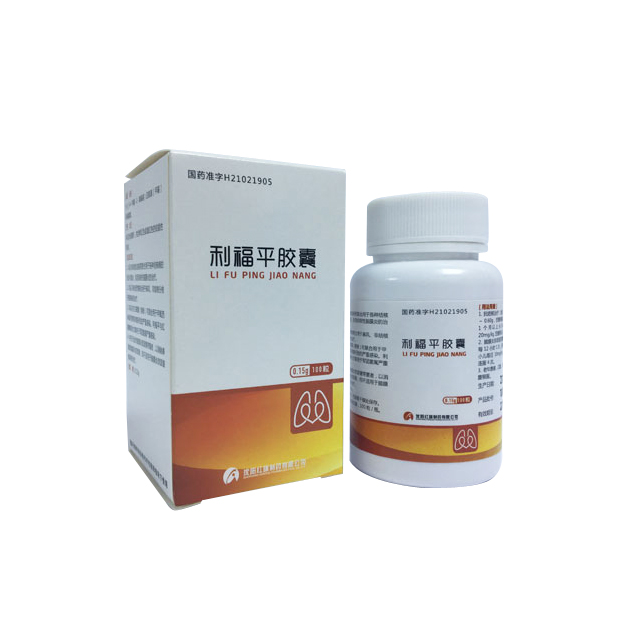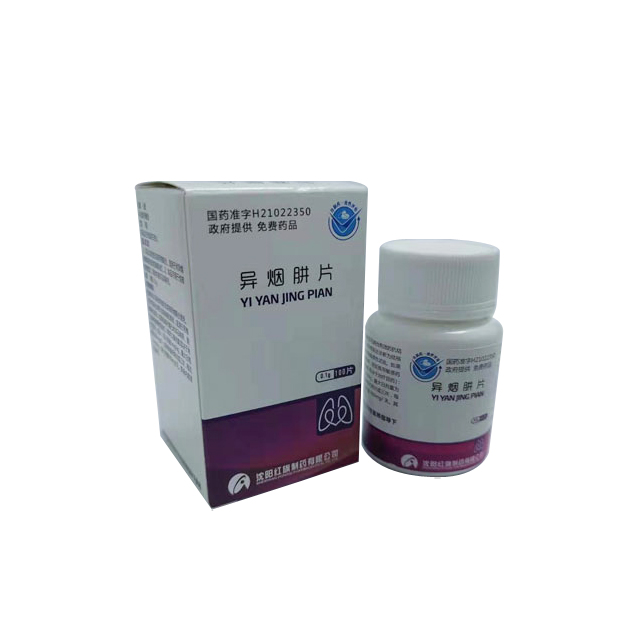Rifampicin Capsule Instructions
Please read the instructions carefully and use under the guidance of a doctor
【Drug Name】
Generic name: rifampicin capsules
English name: Rifampicin Capsules
Chinese Pinyin: Lipuping Jiaonang
【Ingredients】
The main ingredient of this product is rifampicin.
Chemical name: 3-[[(4-methyl-1-piperazinyl)imino]methyl]rifamycin
Chemical Structure:
Molecular formula: C 43 H 58 N 4 O 12
Molecular weight: 822.95
【Properties】
The content of this product is bright red powder or granules.
【Indications】
In order to ensure the effectiveness of rifampicin and other antibacterial drugs and reduce the occurrence of drug resistance, the antibacterial drug treatment plan can be changed or adjusted according to the results of sputum culture and drug sensitivity. If such data are lacking, treatment will be given based on the results of local epidemiology and drug susceptibility experience.
1. This product is suitable for the treatment of various types of sensitive tuberculosis.
2. This product is suitable for the treatment of asymptomatic carriers of Neisseria meningitidis.
It is used for carriers of Neisseria meningitidis without meningitis symptoms to remove meningococcus from the nasopharynx, and a treatment plan is formulated based on the results of serotype and drug sensitivity test. Due to the problem of rapid drug resistance, it should only be used in patients with high risk of meningitis and should not be used in the treatment of patients with meningococcal infection.
3. This product is suitable for the treatment of sensitive non-tuberculous mycobacteria infection.
4. This product can be combined with other drugs to treat leprosy.
5. According to domestic clinical experience, this product can be used for preventive treatment of people at high risk of tuberculosis, but there is no sufficient clinical research data to support it.
【specification】
0.3g
【Dosage】
1. Tuberculosis
(1) Treatment of sensitive tuberculosis
Adults: 10mg/kg per day, no more than 600mg per day, taken before meals. According to the domestic clinical experience, the maximum daily dose should not exceed 1.2g, but there is no sufficient clinical research data to support it.
Children: 10-20mg/kg, no more than 600mg per day, orally before meals.
(2) Prevention of high-risk groups of tuberculosis
Adults: 10mg/kg per day, the maximum daily dose does not exceed 600mg, take a meal before meals.
Children: 10-20mg/kg, the maximum daily dose does not exceed 600mg, take it before meals.
2. Treatment of asymptomatic carriers of Neisseria meningitidis
Adults: 300mg, once every 12 hours, for 2 consecutive days.
Children: 1 month and older, 10mg/kg, once every 12 hours, the maximum daily dose does not exceed 600mg, lasting 2 days. Under 1 month of age, 5mg/kg, once every 12 hours for 2 days.
3. Treatment of non-tuberculous mycobacterial infection
Once a day, 450mg each time, the maximum daily dose does not exceed 600mg.
4. Leprosy treatment
600mg, once a day, orally once or twice a month; or 450mg, once a day, taken before meals. The dose should be adjusted with age or changes in symptoms. Used in combination with other anti-leprosy drugs.
5. For patients with dysphagia or low-dose application of capsules, a suspension aqueous solution can be prepared, the steps are as follows:
A 1% rifampicin suspension (10mg/ml) can be prepared using syrup.
(1) Pour the contents of 4 300 mg or 8 150 mg rifampicin capsules on a piece of weighing paper.
(2) Lightly press the contents of the capsule into a fine powder.
(3) Transfer the rifampicin powder to a 118ml amber glass bottle or plastic bottle (high density polyethylene [HDPE], polypropylene or polycarbonate) medicine bottle.
(4) Rinse the weighing paper and medicine spoon with 20ml of syrup, add to the washing bottle and shake well.
(5) Add 100ml of syrup and shake well.
A 1% rifampicin suspension can be stored for 4 weeks at room temperature (25±3°C) or in the refrigerator (2-8°C). The existing oral suspension must be shaken before use.
【Adverse reactions】
1. The gastrointestinal tract
Some patients will experience burning sensation in the stomach, pain in the upper abdomen, anorexia, nausea, vomiting, jaundice, flatulence, cramps, and diarrhea. Although Clostridium is sensitive to rifampicin in vitro, there are still reports of pseudomembranous colitis after the use of rifampicin (in combination with other broad-spectrum antibiotics), so this diagnosis should be considered when antibiotic-related diarrhea occurs .
2. Liver
It can be manifested as transient abnormalities of liver function indicators (such as increased serum bilirubin, alkaline phospholipase, and transaminase). Rare hepatitis or shock-like syndrome with liver involvement and abnormal liver function.
3. Hematology
Thrombocytopenia usually occurs in the process of high-dose intermittent therapy, and can also occur in the recovery process after interruption of treatment. Supervised and standardized daily medication therapy rarely occurs. Purpura is reversible and disappears after stopping the drug. According to reports, continued use of rifampicin after purpura may cause cerebral hemorrhage and even death.
Leukopenia, hemolytic anemia, and hemoglobin reduction may occur.
Agranulocytosis is rare. Rarely, diffuse intravascular coagulation.
4. Central Nervous System
It can cause headache, fever, drowsiness, fatigue, ataxia, dizziness, inattention, mental drowsiness, behavior changes, muscle weakness, limb pain, and numbness.
Rare reports of mental illness.
5. Ophthalmology
Can cause visual impairment.
6. Endocrine
Can cause menstrual disorders.
There are occasional reports of renal insufficiency in patients with impaired adrenal cortex function.
7. Kidney
Can cause increased serum urea and uric acid. There are occasional reports of hemolysis, hemoglobinuria, hematuria, interstitial nephritis, acute tubular necrosis, renal insufficiency, and acute renal failure. It usually occurs in the process of resuming treatment after the interruption of intermittent medication and daily medication regimen. At present, it is believed that the mechanism is the allergic reaction caused by the drug. It can be relieved after stopping rifampin and symptomatic treatment.
8. Skin
Skin reactions are milder, often self-limiting, usually manifested as skin flushing and itching (with/without rash), not allergic reactions. Severe skin changes caused by hypersensitivity reactions are rare.
9. Allergic reactions
Can manifest as itching, urticaria, skin rash, pemphigoid reaction, erythema multiforme including Stevens-Johnson syndrome, toxic epidermal necrolysis, vasculitis, accompanied by eosinophilia and Systemic symptom syndrome drug reactions, oral ulcers, tongue pain, conjunctivitis.
Reports of allergic reactions are relatively rare.
10. Other
Discoloration of teeth (possibly permanent). Rare muscle lesions have been reported. There have been reports of swelling of the face and limbs. Other reactions to intermittent therapy include "flu-like syndrome" (fever, chills, headache, dizziness, bone pain), shortness of breath, asthma, lowered blood pressure, and shock. "Flu-like syndrome" may also occur in patients with irregular medication.
【Taboo】
Patients who are allergic to rifampicin, rifamycin or other substances contained in capsules are prohibited.
Because it increases the risk of severe drug-induced liver injury, rifampicin is contraindicated in patients receiving ritonavir/saquinavir treatment (see [Drug Interactions]).
Rifampicin is contraindicated in patients receiving atazanavir, darunavir, fosinovir, saquinavir and tepranavir, because rifampicin can significantly reduce the plasma concentration of these antiviral drugs , May lead to reduced antiviral effect and/or virus resistance.
【Precautions】
caveat:
1. Rifampicin can cause drug-induced liver damage, and patients with underlying liver diseases or taking other hepatotoxic drugs at the same time may develop fatal icteric hepatitis. Rifampicin should be used with caution in patients with liver function impairment and only when necessary. Liver function (especially SGPT/ALT and SGOT/AST) should be monitored before treatment and every 2 to 4 weeks during treatment. If there are signs of liver cell damage, stop rifampicin immediately.
2. Some patients may develop hyperbilirubinemia in the early stages of treatment. The reason is that rifampicin and bilirubin compete with the liver for excretion at the cellular level. A slight increase in bilirubin and/or transaminase is not an indication for interruption of treatment. After repeated testing and observation of its trend, a decision should be made in accordance with the patient's clinical situation.
3. Rifampicin has enzyme-inducing properties, including the induction of δ-aminolevulinic acid synthase. Rifampicin-related exacerbations of porphyria have been reported individually.
4. The rapid emergence of meningococcal drug resistance limits the short-term treatment of rifampicin for asymptomatic carriers of Neisseria meningitidis. Rifampicin should not be used to treat patients with meningococcal infection.
5. Rifampicin can cause drug eruption with eosinophilia and systemic symptoms (Drug Reaction with Eosinophilia and Systemic Symptoms, DRESS) (see [Adverse Reactions]). Signs and symptoms of allergic reactions include: fever, rash, urticaria, angioedema, hypotension, acute bronchospasm, conjunctivitis, thrombocytopenia, neutropenia, elevated liver transaminases or flu-like syndrome (weakness, Fatigue, muscle pain, nausea, vomiting, headache, chills, pain, itching, sweating, dizziness, shortness of breath, chest pain, cough, fainting, palpitations). These reactions can be serious or even fatal. Even if the rash is not obvious, it may be allergic, manifested as: fever, lymphadenitis or laboratory abnormalities (including eosinophilia, abnormal liver function).
Monitor patients for signs and/or symptoms of allergic reactions. If it appears, stop using rifampicin and treat symptomatically.
General notes:
1. Diabetes patients are more difficult to manage, and rifampicin should be used with caution.
2. In the case of undiagnosed or not highly suspected bacterial infection, or no indication for prevention, the use of this product may not be beneficial to patients, and it will also increase the risk of drug-resistant bacteria.
3. To treat tuberculosis, rifampicin is usually taken daily. When rifampicin is administered at a dose of more than 600 mg once or twice a week, the incidence of adverse reactions will be higher, including "flu symptoms" (fever, chills, malaise), hematopoietic reactions (leukopenia, thrombocytopenia, acute hemolysis) Anemia), skin, gastrointestinal, liver reactions, shortness of breath, shock, allergic reactions and renal dysfunction.
4. Intermittent application of rifampicin is not recommended to avoid intentional or accidental interruption of the medication. In such cases, when the treatment is resumed, renal hypersensitivity reactions will occur in a very small number of cases. Inform patients that they should continue drug treatment after their symptoms improve in the early treatment. Irregular drug dosage and course of treatment will reduce the efficacy, promote bacterial resistance, and further lead to drug resistance.
5. Rifampicin has enzyme-inducing properties and can enhance the metabolism of endogenous substrates, including adrenal hormones, thyroid hormones and vitamin D. Rifampicin and isoniazid have been reported to alter the metabolism of vitamin D. In some cases, the decrease in circulating levels of 25-hydroxyvitamin D and 1,25-dihydroxyvitamin D is accompanied by a decrease in plasma calcium and phosphate, and an increase in parathyroid hormone.
6. Before taking this product, patients should be informed that rifampicin may cause discoloration of teeth, urine, sweat, sputum and tears (yellow, orange, red, brown). Soft contact lenses may be permanently stained.
7. It may affect the reliability of oral or other systemic hormonal contraceptives, and patients should be advised to use other contraceptive measures.
8. Patients should be informed that they should seek medical attention immediately if any of the following conditions occur: skin rash, fever or swollen lymph nodes, loss of appetite, malaise, nausea and vomiting, dark urine, yellow skin and eyes, cough, shortness of breath, Wheezing, joint pain or swelling.
9. Adults should undergo a baseline test before taking rifampicin. The test content includes liver enzymes, bilirubin, serum creatinine, complete blood count and platelet count. Baseline testing is not necessary for pediatric patients, unless the clinical situation is complicated or suspected.
10. Impact on laboratory inspections:
It has been reported that patients who use rifampicin will have cross-reactions with opioids and false positive urine screening test results when undergoing KIMS (Kinetic Interaction Analysis of Particles in Solution) method. Confirmatory tests, such as gas chromatography/mass spectrometry methods, can distinguish rifampicin from opioids.
Rifampicin at therapeutic doses has been shown to inhibit serum folic acid and vitamin B12 standard microbiological tests. Therefore, alternative detection methods should be considered. Transient abnormalities in liver function tests (for example, increased serum bilirubin, alkaline phosphatase, and serum transaminase) and decreased biliary excretion of contrast agents for biliary tract imaging have also been observed. Therefore, these tests should be performed before taking rifampicin in the morning.
[Medicine for pregnant women and lactating women]
Pregnant women:
There is no clinical study on the application of rifampicin to pregnant women under strict control. Because rifampicin can pass through the placental barrier and appear in the cord blood, it should only be used when the potential benefits outweigh the risks to the fetus.
Rifampicin can cause postpartum mother and infant hemorrhage when administered in the last few weeks of pregnancy, and vitamin K treatment can be given.
Breastfeeding women:
Because rifampicin has shown potential carcinogenicity in animal studies, it is necessary to consider the importance of the drug to the mother before deciding to stop breastfeeding or stop taking the drug.
【Children's Medication】
See 【Usage and Dosage】.
【Geriatric Medication】
Elderly patients with decreased liver function, the dose should be reduced as appropriate.
【medicine interactions】
Healthy subjects taking 600 mg of rifampicin once a day and taking saquinavir 1000 mg/ritonavir 100 mg twice a day (ritonavir-enhanced saquinavir) will cause severe hepatocellular toxicity. Therefore, it is contraindicated to use these drugs at the same time (see [Contraindications]).
Rifampicin can induce certain cytochrome P-450 enzymes. The combination of rifampicin and drugs that undergo biotransformation through these metabolic pathways can accelerate the clearance of the combined drug. In order to maintain the optimal blood concentration, it may be necessary to adjust the dose of the drug metabolized by these enzymes, or stop taking rifampicin.
Rifampicin can significantly reduce the blood concentration of the following antiviral drugs: atazanavir, darunavir, fosiprenavir, saquinavir and tepranavir. These antiviral drugs cannot be used in combination with rifampicin (see [Contraindications]).
Rifampicin can accelerate the metabolism of the following drugs: anticonvulsant drugs (for example: phenytoin), digitoxin, antiarrhythmic drugs (for example: disopyramide, mexiletine, quinidine, tocainide), oral Anticoagulants, antifungals (e.g. fluconazole, itraconazole, ketoconazole), barbiturates, β-blockers, calcium channel blockers (e.g. diltiazem, nifedipine, Verapamil), chloramphenicol, clarithromycin, glucocorticoids, cyclosporine, cardiac glycoside preparations, antuomin, oral or other systemic hormonal contraceptives, dapsone, diazepam, doxycycline Drugs, fluoroquinolones (eg: ciprofloxacin), haloperidol, oral hypoglycemic drugs (sulfonylureas), levothyroxine, methadone, narcotic analgesics, progesterone, quinine, tacrolimus , Theophylline, tricyclic antidepressants (for example: amitriptyline, nortriptyline) and zidovudine. If combined with rifampicin, the above-mentioned drugs need to be adjusted appropriately.
Patients who use oral or other systemic hormonal contraceptives are advised to switch to non-hormonal contraception while taking rifampicin.
Rifampicin can increase the demand for coumarin anticoagulant drugs. When the patient is combined with rifampicin and anticoagulant drugs, it is recommended to monitor the clotting time daily to maintain the effective dose of anticoagulant.
When atroqualone and rifampicin are used in combination, the blood concentration of atroquantone decreases and the blood concentration of rifampicin increases.
The combined application of ketoconazole and rifampin will cause the blood concentration of both to decrease. The combined application of rifampicin and enalapril will cause the concentration of enalapril and its active metabolites to decrease. The dosage should be adjusted appropriately according to the patient's clinical condition during use.
Combination of antacids and rifampicin will reduce the absorption of rifampicin. It is recommended to take rifampicin at least 1 hour before taking the antacid.
Probenecid and compound sulfamethoxazole will increase the blood concentration of rifampicin.
The combination of rifampicin and halothane or isoniazid will increase the risk of liver toxicity. The combination of rifampicin and halothane should be avoided; liver function should be closely monitored when rifampicin and isoniazid are used in combination.
When sulfasalazine and rifampicin are used in combination, the blood concentration of sulfapyridine decreases. It may be due to colonic bacteria reducing the conversion of sulfasalazine to sulfadiazine and aminosalicylic acid.
Para-aminosalicylate can affect the absorption of rifampicin, resulting in a decrease in its blood concentration; if it must be used in combination, the two should be taken at least 6 hours apart.
The combination of rifampicin and ethionamide can increase its adverse reactions.
Chlorophenazine can reduce the absorption of rifampicin, the peak time is delayed and the half-life is prolonged.
【Overdose】
The minimum acute lethal dose or the minimum toxic dose has not been determined. However, it is reported that the non-fatal acute drug overdose of rifampicin in adults ranges from 9 to 12 g, and the fatal acute drug overdose ranges from 14 to 60 g. In fatal and non-fatal cases involving drinking or a history of alcohol abuse. According to reports, in children aged 1 to 4 years, one or two doses of 100 mg/kg caused a non-fatal drug overdose.
1. Signs and symptoms:
Nausea, vomiting, abdominal pain, itching, headache, drowsiness, and coma may occur in patients with severe liver disease within a short period of time. Liver enzymes and bilirubin may increase temporarily. The skin, urine, sweat, saliva, tears, and feces will change to brownish red or orange, and the color is directly proportional to the amount taken.
Liver enlargement can occur within a few hours after a severe overdose, possibly accompanied by tenderness. The level of bilirubin may rise, and jaundice can develop rapidly. Liver-related symptoms may be more pronounced in patients who have had liver damage before. Other signs are basically normal. It is unlikely to have an effect on the hematopoietic system, electrolyte or acid-base balance.
Facial or periorbital edema has also been reported in children. Some deaths have reported reports of hypotension, sinus tachycardia, ventricular arrhythmia, seizures and cardiac arrest.
2. Treatment
Strong supportive treatment should be given, and treatment should be given immediately when symptoms appear. Keep breathing unobstructed and provide respiratory support. Nausea and vomiting may occur. Gastric lavage within 2 to 3 hours after taking it is preferable to inducing vomiting. After the stomach contents are emptied, injecting the activated charcoal suspension into the stomach may help absorb the remaining medicine in the gastrointestinal tract. Antiemetic drugs can help relieve severe nausea and vomiting.
Active diuresis (by measuring intake and excretion) will help promote drug excretion.
Severe cases may require extracorporeal hemodialysis. If hemodialysis is not possible, peritoneal dialysis can be combined with a strong diuretic.
【Pharmacology and Toxicology】
Pharmacological action
Mechanism:
Rifampicin can inhibit the DNA-dependent RNA polymerase activity of sensitive Mycobacterium tuberculosis bacteria. The special feature is that rifampicin interacts with bacterial RNA polymerase but does not inhibit mammalian enzymes.
Resistance:
Microorganisms resistant to rifampicin may be resistant to other rifamycins.
In the treatment of tuberculosis and meningococcal carriers (see [Indications]), a small number of resistant bacteria among a large number of sensitive bacteria will quickly become dominant. In addition, it has been determined that rifampicin resistance occurs in a single-step mutation of DNA-dependent RNA polymerase. In view of the rapid emergence of drug resistance, once the bacterial culture continues to be positive, appropriate drug susceptibility tests should be carried out.
In vitro and in vivo activity:
Rifampicin has antibacterial activity against chronic and intermittent growth of Mycobacterium tuberculosis in vitro.
In in vitro tests and clinical infections described in [Indications], rifampicin showed antibacterial activity against most strains of the following bacteria.
Aerobic gram-negative bacteria:
Neisseria meningitidis
"Other" bacteria:
Mycobacterium tuberculosis
The following in vitro test data has been obtained, but its clinical significance is unknown.
Rifampicin is active against most strains of the following bacteria in vitro; however, the safety and effectiveness of rifampicin in the treatment of clinical infections caused by these bacteria have not been determined in sufficient and well-controlled clinical trials.
Aerobic Gram-positive bacteria:
Staphylococcus aureus (including methicillin-resistant Staphylococcus aureus/MRSA)
Staphylococcus epidermidis
Aerobic gram-negative bacteria:
Haemophilus influenzae
"Other" bacteria:
Mycobacterium leprosy
The production of β-lactamase should have no effect on rifampicin activity.
drug allergy testing:
Before starting treatment, appropriate specimens should be collected to identify infectious bacteria and conduct an in vitro susceptibility test.
In vitro test of Mycobacterium tuberculosis isolates:
Two standardized in vitro susceptibility test methods can be used to detect the sensitivity of rifampicin to Mycobacterium tuberculosis. Agar ratio method (CDC or CLSI M24-A): Use Middlebrook 7H10 medium and add rifampicin at a final concentration of 1.0 μg/mL to determine drug resistance. After three weeks of cultivation, the MIC99 was calculated by comparing the amount of bacteria grown in the drug-containing medium and the control medium. The growth of mycobacteria in the presence of the drug is ≥1% compared with the control, indicating drug resistance.
Radioactive broth method: use BACTEC 460 to compare the growth index (GI) of drug-free medium and medium containing 2 μg/ml rifampicin. The test needs to strictly abide by the manufacturer's sample processing method and data analysis.
The drug susceptibility results obtained by the above two different methods are only comparable when rifampicin is used at the above concentrations. Both methods require the use of Mycobacterium tuberculosis H37Rv ATCC 27294 as quality control bacteria.
The clinical relevance of in vitro susceptibility test results for mycobacteria other than Mycobacterium tuberculosis using the radiation method or the ratio method is not yet clear.
In vitro test of isolated strains of Neisseria meningitidis:
Dilution method: A quantitative method for determining the minimum inhibitory concentration can provide a repeatable assessment of the susceptibility of bacteria to antibacterial drugs. One such standard method uses a standard dilution method (broth method, agar method, or microdilution method) or an equivalent amount of rifampicin powder. The MIC value obtained should be interpreted according to the following criteria for Neisseria meningitidis:
|
MIC (μg/mL)
|
Interpret
|
|
≤1
|
( S ) Sensitive
|
|
2
|
( I ) Intermediary
|
|
≥4
|
( R ) Resistance
|
Reporting as "sensitive" (S) means that the antibacterial drug may inhibit the growth of pathogenic bacteria at a concentration that is usually achievable in the blood. Reporting as an "intermediary" (I) indicates that the results are ambiguous, and if the microorganism is not fully sensitive to clinically available alternative drugs, the test should be repeated. This category means the possible clinical applicability of the drug in the body part where the drug is physiologically concentrated or at the maximum acceptable dose. This category provides a buffer zone to prevent small, uncontrollable technical factors from causing major differences in interpretation. Reporting as "resistance" (R) means that the usual achievable concentration of antibacterial drugs in the blood may not inhibit the growth of pathogenic bacteria, and other treatment methods should be selected.
The determination of MIC or minimum bactericidal concentration (MBC) and the achievable concentration of antibacterial drugs can guide the treatment of some infections.
The standard drug susceptibility test method requires the use of laboratory quality control strains. The use of these strains does not imply clinical efficacy (see [Indications]), but is used to control the technical aspects of the experimental process. The rifampicin standard should give the following MIC values.
|
Strains
|
|
MIC (μg/mL)
|
|
Staphylococcus aureus
|
ATCC 29213
|
0.008~0.06
|
|
Enterococcus faecalis
|
ATCC 29212
|
1~4
|
|
Escherichia Coli
|
ATCC 25922
|
8~32
|
|
Pseudomonas aeruginosa
|
ATCC 27853
|
32~64
|
|
Haemophilus influenzae
|
ATCC 49247
|
0.25~1
|
Diffusion method: A quantitative method for measuring the diameter of the zone of inhibition can provide a repeatable assessment of the susceptibility of bacteria to antibacterial drugs. A recommended standard method is the plate method, in which the sensitivity of the strain is tested in a plate containing 5 μg rifampicin. Interpret the correlation between the diameter of the inhibition zone obtained from the plate test and the MIC value of rifampicin.
The results of the standard single-disc drug sensitivity test of 5 μg rifampicin plates should be interpreted according to the following criteria of Neisseria meningitidis:
|
Inhibition zone diameter (mm)
|
Interpret
|
|
≥20
|
( S ) Sensitive
|
|
17-19
|
( I ) Intermediary
|
|
≤16
|
( R ) Resistance
|
The interpretation method for the results of the dilution method as described above should be used for interpretation.
Like the standard dilution method, the diffusion method requires the use of laboratory quality control strains. The use of these strains does not imply clinical efficacy (see [Indications]), but is used to control the technical aspects of the experimental process. For the following quality control strains, a 5 μg rifampin plate should give the following inhibition zone diameter:
|
Strains
|
|
Inhibition zone diameter (mm)
|
|
Staphylococcus aureus
|
ATCC 25923
|
26~34
|
|
Escherichia Coli
|
ATCC 25922
|
8~10
|
|
Haemophilus influenzae
|
ATCC 49247
|
22~30
|
Toxicology Research
Genotoxicity: Rifampicin has no mutagenicity in prokaryotic bacteria (Salmonella typhi, Escherichia coli), eukaryotic bacteria (yeast), fruit flies, or ICR/Ha Swiss mice. When whole blood cell cultures were given rifampin, increased chromosomal breakage was seen. In vitro tests of lymphocytes obtained in patients treated with rifampicin, isoniazid, pyrazinamide and streptomycin, rifampicin, isoniazid, and pyrazinamide were observed to increase the rate of chromosomal aberrations.
Reproductive toxicity: Rifampicin has teratogenic effects on rodents. Rifampicin 150-250 mg/kg/day (based on body surface area, about 1-2 times the maximum recommended dose of humans) was given to pregnant rats during the organogenesis period. Congenital malformations and increased spina bifida were seen in the offspring . In fetuses of pregnant mice administered orally at a dose of 50-200 mg/kg (based on body surface area, about 0.2-0.8 times the maximum recommended dose of humans), the cleft palate showed a dose-dependent increase. The oral dose of rifampicin to pregnant rabbits is as high as 200 mg/kg/day (based on body surface area, about 3 times the maximum recommended dose of humans), showing osteogenesis imperfecta and embryo toxicity.
Carcinogenicity : In humans, several cases of accelerated growth of lung cancer have been reported, but the causal relationship with drugs has not yet been determined. Female CH3f/DP mice were given 20-120 mg/kg of rifampicin (based on body surface area, equivalent to 0.1-0.5 times the maximum human dose) for 60 consecutive weeks, and then observed for 46 weeks, the incidence of liver cancer increased. There was no carcinogenicity in a similar test in male C3Hf/DP mice or BALB/c mice, or a two-year test in Wistar rats.
【Pharmacokinetics】
Rifampicin is well absorbed orally. The peak-to-peak serum drug concentrations of healthy adults and pediatric populations vary greatly among individuals. After a single oral administration of 600 mg of rifampicin in healthy adults, the average peak serum concentration of the drug was 7 μg/ml, and its distribution range was 4 to 32 μg/ml. When the drug and food are taken at the same time, the absorption of rifampicin is reduced by 30%.
Rifampicin is widely distributed in the body and can reach effective concentrations in various organs and body fluids, including cerebrospinal fluid. The plasma protein binding rate is about 80%, and most of the unbound drugs are non-ionized, so they can diffuse freely into the tissues.
In healthy adults, the average biological half-life of rifampicin in serum is 3.35±0.66 hours for oral 600mg dose, 5.08±2.45 hours after increasing to 900mg dose. After repeated administration, the half-life decreases, with an average of about 2 to 3 hours. For patients with renal failure, when the daily dose does not exceed 600 mg, there is no effect on the half-life, so there is no need to adjust the dose; when the daily dose reaches 720 mg, the effect on the half-life has not been determined; when patients with varying degrees of renal insufficiency When a single oral dose reaches 900mg, for patients with glomerular filtration rates of 30-50ml/min, less than 30ml/min, and anuria, the average half-life will increase from 3.6 hours for healthy adults to 5.0 hours, respectively. 7.3 hours and 11.0 hours.
After the drug is absorbed, it is quickly excreted by bile and enters the hepato-intestinal circulation. During this process, rifampicin is continuously deacetylated. Almost all the drugs in the bile are present in the form of deacetylation within 6 hours of taking the drug. This metabolite has antibacterial activity. Deacetylation reduces intestinal reabsorption and promotes excretion. Up to 30% of the drugs are excreted in the urine, of which the prototype drugs account for about half.
In a study, pediatric patients between 6 and 58 months of age were given rifampicin suspension mono syrup or drug dry powder applesauce mixture at a dose of 10 mg/kg before meals, and the plasma concentration of the drug was 10.7 ± 1 hour after administration. 3.7μg/ml and 11.5±5.1μg/ml, the half-life of the two modes of administration is 2.9 hours. It is worth noting that in other studies, the average peak serum drug concentration of the pediatric population after administration at a dose of 10 mg/kg was 3.5 to 15 μg/ml.
【Storage】
Seal and store in a dark and dry place.
【package】
Oral solid medicine is packed in a high-density polyethylene bottle, 50 capsules/bottle.
Oral solid medicine is packed in high-density polyethylene bottle, 60 capsules/bottle.
【Validity Period】
12 months
【Executive Standard】
YBH05022019
【Approval Number】
National Medicine Standard H21022450
【manufacturer】
Company Name: Shenyang Hongqi Pharmaceutical Co., Ltd.
Production address: No. 6, Xinluo Street, Hunnan New District, Shenyang City
Postal Code: 110179
Phone number: (024) 23786260 23786261
Fax number: (024) 23786263
Website: www.hongqipharma.com




